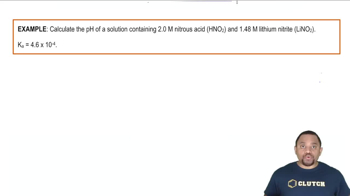Henderson-Hasselbalch Equation definitions Flashcards
 Back
BackHenderson-Hasselbalch Equation definitions
1/10
Terms in this set (10)
- Henderson-Hasselbalch EquationA formula used to calculate the pH of a buffer solution using pKa or pKb and the ratio of conjugate base to weak acid or conjugate acid to weak base.
- BufferA solution that resists changes in pH when small amounts of acid or base are added, typically composed of a weak acid and its conjugate base or a weak base and its conjugate acid.
- Conjugate Acid-Base PairA pair of compounds that transform into each other by gain or loss of a proton, crucial in buffer solutions.
- pKaThe negative logarithm of the acid dissociation constant, indicating the strength of an acid in solution.
- pKbThe negative logarithm of the base dissociation constant, indicating the strength of a base in solution.
- MolarityA measure of concentration, defined as the number of moles of solute per liter of solution.
- MolesA unit of measurement for amount of substance, representing Avogadro's number of particles.
- pH RangeThe range within which a buffer effectively resists changes in pH, typically pKa ± 1.
- ConcentrationThe abundance of a constituent divided by the total volume of a mixture, often expressed in molarity.
- LogarithmA mathematical operation that is the inverse of exponentiation, used in the Henderson-Hasselbalch equation.



